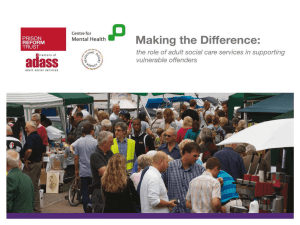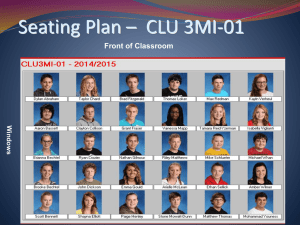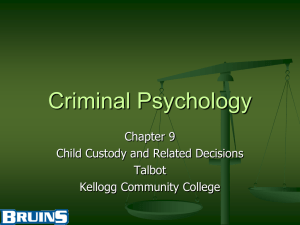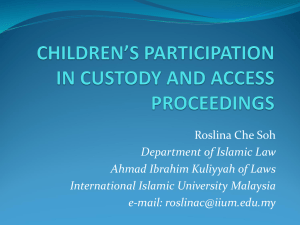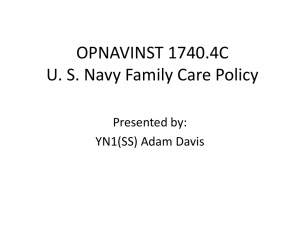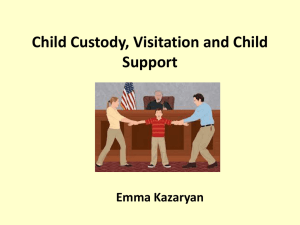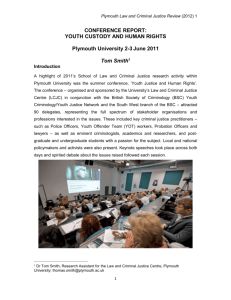Youth Mental Health Court Worker Program
advertisement
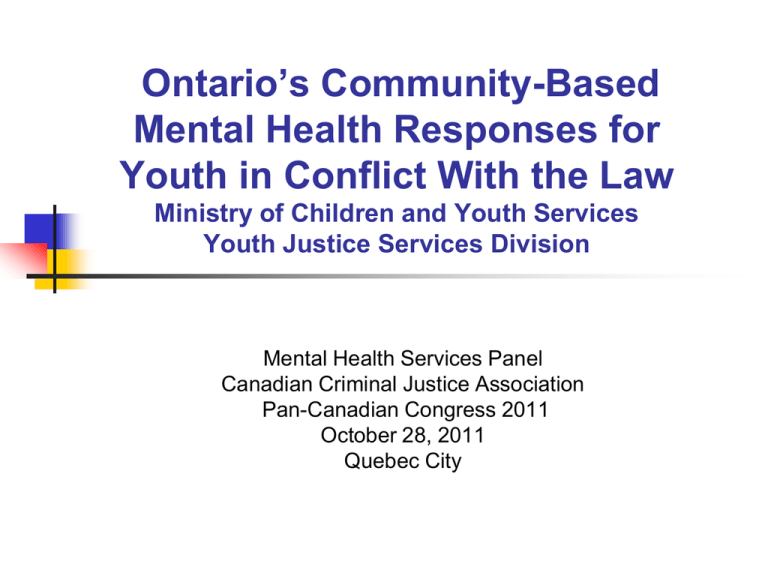
Ontario’s Community-Based Mental Health Responses for Youth in Conflict With the Law Ministry of Children and Youth Services Youth Justice Services Division Mental Health Services Panel Canadian Criminal Justice Association Pan-Canadian Congress 2011 October 28, 2011 Quebec City Ontario’s Community Based Mental Health Responses for Youth in Conflict with the Law Focus: Profile of child/youth mental health in Ontario including youth in conflict with the law Drivers of Change supporting community based responses Community-Based Services Profile “A Closer Look”: 2 Examples of Community-Based Mental Health Programs Youth Mental Health Court Worker Program Intensive Support and Supervision Program 2 Profile of Child & Youth Mental Health in Ontario Ontario Children’s Mental Health Association observation that 1 in 5 (20%) of all children and adolescents experience mental health difficulties. Approximately 30% of youth (defined by Canadian Mental Health Association as age 12-24) who have accessed concurrent disorder services are involved in the legal system and young people between the ages of 15-24 are three times more likely to have a substance abuse problem than people over 24. Anecdotally, people working with youth in the justice system suggests between 40% to 60% of youth have mental health needs ranging from mild to severe (i.e.: Psychiatric, Anxiety, Mood, Sexual, Developmental and Conduct Disorders) 2010/11 admissions to open /secure custody/residential indicates that 18.2% of youth admitted into the system have an identified mental health need 24% of 430 youth sentenced to secure custody have an identified mental health need 3 Drivers for Change that Support Community Based Action The Youth Criminal Justice Act: focus on prevention, diversion, rehabilitation, addressing the underlying causes of youth crime, and reserving custody for most serious offences. Ministry of Children and Youth Services 2003 Research: Evidence Base Practices and Programs Need for differential responses for youth with mental health needs in Justice system 4 All Youth Justice Sentences Have a Component Served in Community Full Community Programming Least restrictive community based orders May be supervised by MCYS Partial More restrictive & custody orders Supervised by MCYS Any sanction or any number that are not inconsistent with each other 5 Community Based Programs: Number of Youth Served and Number of Programs Diversion 10,000 94 99 90 8,000 6,000 10,386 10,390 10,268 120 11,119 10,438 94 100 91 80 59 60 4,649 4,000 40 2,000 20 0 # of Programs # of Youth Served 12,000 0 05/06 06/07 07/08 08/09 09/10 10/11 Includes: Pre-charge EJM, Post-charge EJS, YMHCW 6 Youth Mental Health Court Worker Program Program Design and Origin Service Delivery Model How Does the Program Work Program Trends/Observations Program Rationale: What is the Goal and Why Challenges and Lessons Learned Moving Forward Next Program Steps 7 Youth Mental Health Court Worker Program Design and Origin The 2004 Ontario Budget committed to expanding community mental health services to serve an additional 78,600 clients by 2007-08 and included $50.0M annualized funding in services to support diversion of youth and adults with mental health issues from the criminal justice and correctional systems Flow through Model (moves clients briskly to services) Facilitates the diversion of youth whose primary issues are related to mental health, not criminal behaviour Supports MCYS continuum of integrated services Supports continuity of service bridging youth who cross-over to adult mental health system Expands and develops community partnerships 8 Client may enter auspice of Youth Mental Health Court Worker through any referral avenue: self referral, family/ caregiver, crown/defence attorney, judge, administrative staff, historical (known to court as consumer of services). Client eligible for supports at first opportunity regardless of charge election of court process, family supports, ward status. Crown Attorney elects to divert before court process Youth elects to proceed with court process Diversion at Sentencing Custody Sentence Stay/Withdrawal Probation Services Community Services Service Delivery Model When sentenced to Custody the Probation Staff and YMHCW cooperate to inform facility of youth mental health status. When custody portion completed client is re-linked with community services Youth Mental Health Court Worker Program Trends and Observations Average age of youth 16 yrs Over 3000 youth served to date 20% year over year increase; Approx 1/3 of Youth outside age range; 1/3 Youth diverted out of system; 1/3 Youth elect to proceed at court. Challenges: Success creates greater demand for community services. Lessons Learned: Inclusive Communications Strategy; Court House Office Accommodations; Program Continuity: Implementation Guide. 10 Youth Mental Health Court Worker Moving Forward & Next Steps 2011/12 expansion to 45 of 54 Ontario Courts service for approximately 95% of all youth matters in Ontario aged 12-17 as per YCJA Next Steps Provide support and linkages during the program operationalization roll-out Promote continued partnerships education awareness (courts, community, child/youth mental health systems) Continued support for community of practice network to promote problem solving and smooth operations 11 Intensive Support and Supervision Program Program Design and Origin Service Delivery Model How Does the Program Work Program Trends/Observations Program Rationale: What is the Goal and Why Challenges and Lessons Learned Moving Forward Next Program Steps 12 Intensive Support and Supervision Program Origin 1998 Fed Youth Justice Renewal Initiative 2003 Youth Criminal Justice Act April 1, 2004 Ministry of Children And Youth Services 2005 Intensive Support & Supervision Program 13 Ontario’s Intensive Support and Supervision Program Design Research indicates that community programs are more likely to reduce recidivism than custody (Andrews and Bonta, 1998; Lipsey and Wilson, 1997) Program targets youth with behaviours more related to mental health/illness needs than criminogenic factors Small target population with a high potential for improvement in the community, low potential in custody (Henggeler, 1989). Offences significant enough to result in custody sentences, but with appropriate supervision and support, could be safely and effectively managed in their communities (cost effectiveness) Mental health system often challenged to respond well to youth in conflict with the law 2010/11 fiscal program budget $3,393,281.00 14 Service Delivery Model Offence: Young person enters youth criminal justice system via offence that qualifies for custody. Anyone may alert court regarding program suitability. Court: Referral for program suitability to service provider Service Provider Evaluation in Cooperation Probation Officer Eligibility Criteria: Young person 12-17 years diagnosed mental health need DSM Axis 1 and require on going clinical intervention and continuous support; Voluntary consent; Family/ supportive persons; would likely receive a custody sentence without ISSP; can be safely supervised in the community Court Determination on basis of plan, guilty plea and consent Yes ISSP Accessed as Condition of Probation NO Youth Justice Court Hearing YCJA Sentences Develop Program Plan Clinical Programming Community or Post Supervision Services Withdrawal of Consent 15 Intensive Support and Supervision Program Trends and Observations Average age of youth 16 yrs Over 700 youth served to date 117 Average Annual Program Total Average 22 per Program Challenges: Staffing pressures, court & family challenges, Dual Diagnosed and Adult system challenges Lessons Learned: Need for a communications strategy to respond to changes in program or court personnel, keeping them apprised of the program goals and criteria and reinforcing the corporate/service provider relationship including probation services and education sector 16 Intensive Support and Supervision Moving Forward & Next Steps Support Outcome Evaluation Continue support for Community of Practice Promote partnerships and education awareness (courts, community, child/youth mental health systems) 17 Community Based Mental Health Responses for Youth Continuing Priorities for Ontario Continue broadening awareness of alternatives to custody for youth with Mental Health needs Links with children’s mental health sector Cross-jurisdictional Education exchange Broad partnership/relationship building Relations with Agencies and Probation Ensure youth are in the right system: mental health system not justice system 18 Community-Based Mental Health Responses for Youth in Conflict With the Law Trish Moloughney Director, Planning and Program Development Branch, Youth Justice Services Division, Ministry of Children and Youth Services Trish.moloughney@ontario.ca 19
